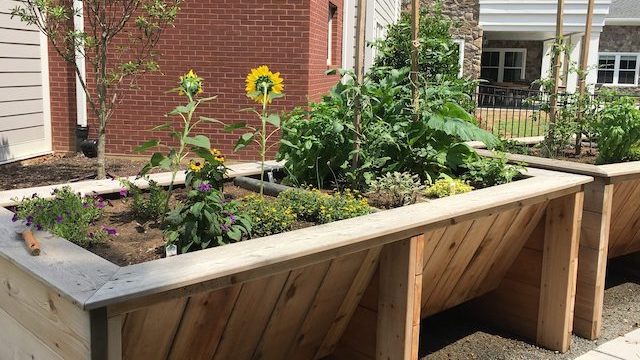
In my first months as the PYM aging support coordinator, I reached out to many of the Quaker aging communities in Philadelphia Yearly Meeting. One interesting resident focused activity I kept hearing Friends bring up was gardening. Around the world, gardening has been recognized for its values of reducing stress, improving moods, providing opportunities for exercise, mobility, socialization, and community outreach while connecting with all aspects of nature. Perhaps Quakers feel particularly connected to gardening because of the quiet peace time with plants provides. More than that, Quakers have also found that gardening reflects our concern for the natural world.
Barclay Friends Cultivates Numerous Raised Gardens
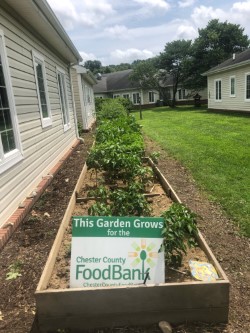
Barclay Friends provides gardening for “meeting the residents where they are both mentally and physically” according to Cheryl A. Bjornson, recreation/horticulture therapist. One resident, Ms. Emma, had lived on a farm. Her memories from her days on the farm are exhibited in her joy of watching tomatoes grow and then tasting them. Recently, staff noted her love of farms in her painting of a horse which is displayed in the community.
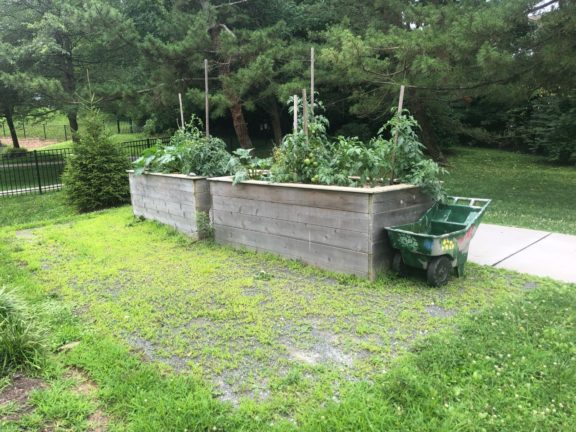 There are numerous raised gardens throughout the Barclay Friends community and many are accessible for those using rollators, wheelchairs and standing. Gardening is accessed from each wing through secure walking areas on patios and for those in memory care in a figure eight, “never ending area.” The plan provides an area for residents to gather for music, bird watching and one on one planting activity. Some residents started their plants under grow lights from seeds and found watching the plants thrive an important and rewarding experience.
There are numerous raised gardens throughout the Barclay Friends community and many are accessible for those using rollators, wheelchairs and standing. Gardening is accessed from each wing through secure walking areas on patios and for those in memory care in a figure eight, “never ending area.” The plan provides an area for residents to gather for music, bird watching and one on one planting activity. Some residents started their plants under grow lights from seeds and found watching the plants thrive an important and rewarding experience.
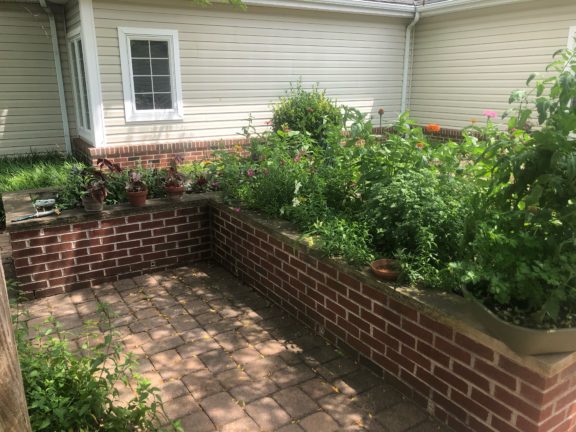 Residents in Preston Assisted Living are helping with community service gardening for Chester County food bank. Volunteers and Cheryl Bjornson take the food to the food bank after residents have pulled the peas off of vines and sorted the produce for delivery. West Chester University and the local community were given garden areas for planting. Providing for the community is a special enhancement to their gardening program. There’s an inter-generational component to their gardening program with the University and the community.
Residents in Preston Assisted Living are helping with community service gardening for Chester County food bank. Volunteers and Cheryl Bjornson take the food to the food bank after residents have pulled the peas off of vines and sorted the produce for delivery. West Chester University and the local community were given garden areas for planting. Providing for the community is a special enhancement to their gardening program. There’s an inter-generational component to their gardening program with the University and the community.
Foxdale Village Creating a Place of Beauty and Renewal
Foxdale Village initiated a project, according to CFO Deb Shughart, with their Landscaping and Gardening Committee to construct and plant a miniature version of Penn State University Arboretum. Their shared goal is “to be a place of beauty and renewal, a venue for the arts, and a pathway to discovery and enrichment.”
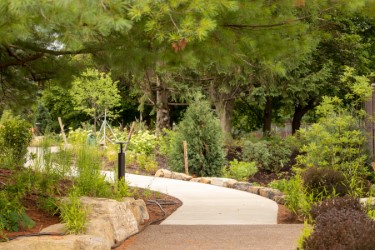
According to Adam Day, environmental director and Derek Kelp, landscape architect at Penn State and Foxdale Village, working with the residents was integral in planning the garden. The garden is a place to “provide beauty and functionality which supports pollinators and birds.” Several residents who are bird watchers and bird banders advised the plan to include a natural stone bird bath. Up top there’s a marsh area for plants while the loose stones allow for bee nesting. With the planting of native plants, shrubs, perennials, and grasses the area will attract all the new residents, birds and bees!
Lisa Harrington, director of residency planning/marketing, introduced the residents whose comments follow. The photos, taken by Jessica McKeon, Residency Planning Coordinator, thoughtfully include flowers, paths, and water with a bird enjoying the day for this article.
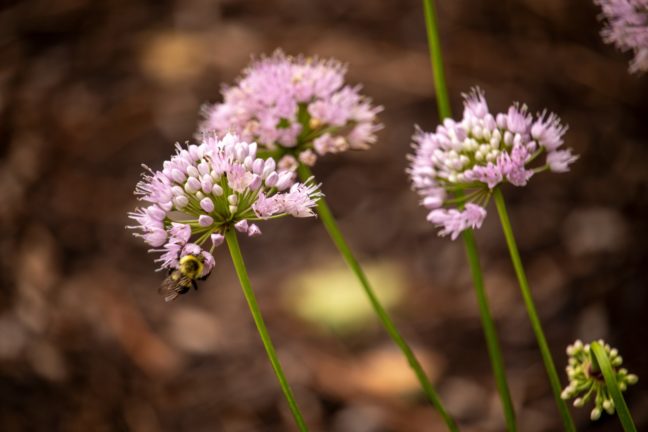
Doug Miller, Foxdale Village resident, shared the following with me. “As a member of the adjacent State College Friends School’s Quaker Life Committee (and also of State College Monthly Meeting) I have been excited to talk with the new head of the school about ways that Friends School students can enjoy the bird garden on their way to the nearby public park. The students and teachers frequently include a walk to that park in their daily schedule, and we have discussed having the garden’s designer meet with them to describe the many features which have been included. Over the coming years the garden can become a regular teaching opportunity for teachers on their way to the park. The park will also offer possibilities for some Foxdale residents to share time there with some Friends School students in the years ahead. It would be fun to sit on a bench there with a student and read a good nature book together.”
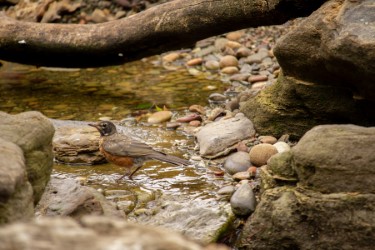
Nick Kerlin, clerk of the landscape and garden committee shared that “time outdoors in the bird garden will provide mental, physical and social benefits to all residents. Enjoying the songs, colors and behavior of birds combined with the beauty of the plants attracting them will be a never ending enjoyment.” Gary Metzger, a new resident with his wife, Joan, were “drawn to Quaker values and direction. Nature lovers and bird watching enthusiasts, they were really excited to watch this beautiful new space that is sure to serve as a refuge for many creatures that struggle in modern human dominated landscapes. Gary noted, now we just need to decide where to hang the new bird feeders!”
A Self Taught Gardener Creating Biodiversity at Friends Village
Friends Village has an incredible resource in Maia Simon and her Native Plants Project. A self learner, Maia shared insights into ecological
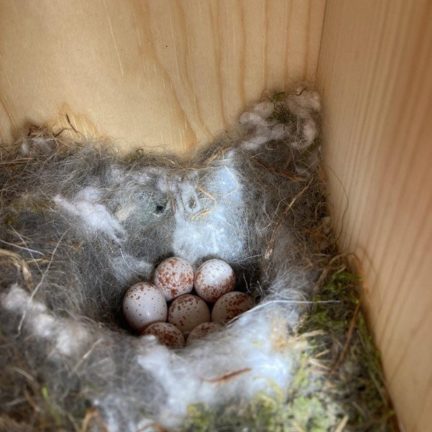
systems and what we can do to reestablish native plants. A goal is to have purposeful planting with 65% native and 35% exotic at Friends Village. Their resident committee proposed guides for personal garden spaces and public spaces to management and then led the way through fundraising for raised beds. The areas are accessible for all except the deer! Impact includes insects and birds who add to the beauty of their efforts.
Maia Simon has gardening penned blogs for the community and recognized that the value of residents committee efforts may attract new residents. In a recent blog, Maia noted how the committee “last fall found overgrown lilac bushes which they cut back and which in spring began to come back happy and healthy. They discovered a native black cherry tree that had been embedded in one of the lilacs. That lilac has been removed to allow the cherry tree to grow. Native cherry trees are a ‘keystone plant’. Keystone plants are natives that are essential to our ecosystems because they support 90% of the caterpillar species that enable our terrestrial birds to reproduce, as well as all of our specialist native bee species.”
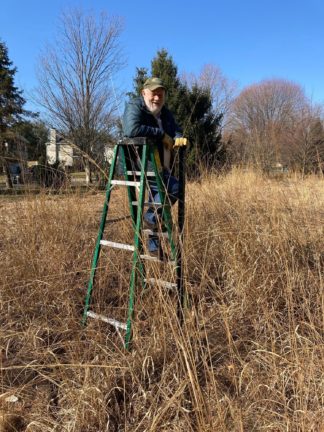
Maia noted that “native plants are being added all over the place. Coreopsis and purple coneflower have been added to the existing non-native but lovely mock orange in the courtyard at B cluster. The residents in D cluster asked the garden committee to help replace non-native and invasive plants in their common garden. This is a multi-year project. So far we have planted purple coneflower, brown eyed daisy, blue wild indigo, sweetspire, with plans to add bee balm and coreopsis. West Wing residents enjoy spending time on the patio and have been troubled with mosquitos in previous summers. The garden committee has installed plants to attract dragonflies whose favorite food is mosquitos.” Through the benefits shared for discovery, growth, enthusiasm and development, the Friends Village committee is helping their community and environment to grow and thrive.

Resource: Native Plants (pa.gov)
Writer: PYM Aging Support Coordinator, Sheila Sorkin
This article is part of the To Brighten Your Day series: stories that explore the lives of our aging community members in the Philadelphia Yearly Meeting. Learn more about Quaker Aging Resources focus on telling the stories of aging Quakers.